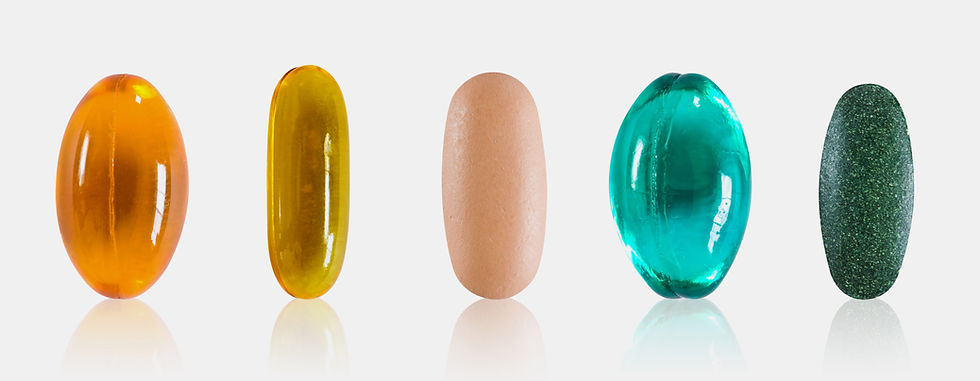Supplements: Choose Wisely
- Dr. Wes Cetnarowski

- May 10, 2023
- 3 min read
Updated: Jan 7, 2024
There is continuing worldwide interest in dietary supplements.

More than 50% of adults and children worldwide use dietary supplements with the motivation to improve or maintain overall health for specific conditions where immunity really matters.
Unfortunately, the presence of lower quality products in the marketplace has raised concerns among consumers and health care practitioners, and rightfully so, in my view. For example, products may have too little of the claimed dietary ingredient, contain extraneous material, or maybe adulterated with actual drugs. Ingredients in the supply chain may also be misidentified or contaminated with toxic materials. Such reckless examples are not only dangerous but clearly point to profits over product quality and safety.
In order to address the potential harm introduced by low-quality ingredients and products, additional mechanisms to support the current regulatory requirements need to be in place to ensure the delivery of quality products to consumers. Industry self-regulatory practices, individual company controls, the use of public standards, verification services, and reference materials should be part of the preventive network to ensure quality.
For our products at Aspida BioNutrition, we follow the PTQ Principle: Protection. Trust. Quality.
Aspida is Greek for shield. Our products are formulated to equip the immune system with the support it needs to effectively shield the body from harmful threats. We operate with transparency and integrity. Our products are ethically produced and GMP-certified, always produced and controlled according to the highest manufacturing standards.
Our ingredients meet the highest standards for sourcing, testing, quality, and safety, including being third-party-verified for their purity and strength, and meet our high-quality standards. Here are some checkpoints to use as a first-pass screening tool to try to weed out the bad guys when it comes to what you’re including in your daily routine. If you see any of the following ingredients on a supplement label, pause — it’s a sign that the company could prioritize their profits over your health.
Certain synthetic vitamin forms
Different nutrient forms have varying degrees of absorption and utilization, and unless you know what to look for, it’s hard to tell if a product has superior or inferior forms. Many of us also have genetic predispositions that make the conversion of synthetic nutrient forms to active nutrient forms less efficient. In these cases, we might be taking a supplement with the hope that we can use it effectively. While the superior vitamin forms are more expensive, they can be worth it for those looking to prioritize efficacy.
Mineral oxides, carbonates, and salts
Minerals can get a bit tricky. Not only do they have to be obtained through food or supplements since the body can’t make them, but they can also compete for absorption. Lower-quality supplements (that cost less to the manufacturer) are often harder to break down and pass through the digestive lining. These inferior options can sometimes be found in the form of mineral carbonates, mineral salts, or oxide forms. For example, check labels to see if your supplement contains zinc oxide,, which provides poor absorbability. Some studies have shown that, when ingested, certain individuals have nearly no (zero) capability to absorb zinc from zinc oxide.
Unnecessary binders, coatings, preservatives, or excipients
To manufacture a supplement successfully, production processes must run smoothly while also maintaining product stability, adequately preserving the integrity of nutrients, and allowing the delivery form to be broken down and usable by the body by the time we actually take them. Because of all these factors, it’s necessary for all supplements to contain additives beyond just the active ingredients. However, and not surprisingly, some of these additives, or binders, coating, preservatives, and excipients (which help deliver active substances), vary significantly in both cost and impact on the final product.
Artificial sweeteners, flavors, and dyes
When it comes to colors, flavors, and sweeteners, aim to go all-natural whenever possible. Some evidence shows possible links between artificial sweeteners and imbalanced gut health and blood-sugar regulation. Other research suggests that with our four-fold increase in consumption in the last 50 years, artificial flavors could be a potential contributor to ADHD and behavioral issues, and artificial colors and dyes in regular, large doses have been suggested to have carcinogenic activity. Artificial ingredients to look out for include:
Synthetic colors such as FD&C, brilliant blue, Red 40, Yellow 5, and Yellow 6
Artificial sweeteners such as sucralose, acesulfame potassium, and aspartame
Artificial flavors
While these ingredients shouldn’t cause fear or panic, there’s no health benefit to using them — and there are supplement options available with better alternatives. Plus, considering that most supplements are taken as part of a daily routine, it can be prudent to make some swaps.
Choose Aspid RDZ. It’s naturally phenomenal. The right supplement, at the right dose, for the right defense.
Until next time, take care of yourselves and each other.



Comments